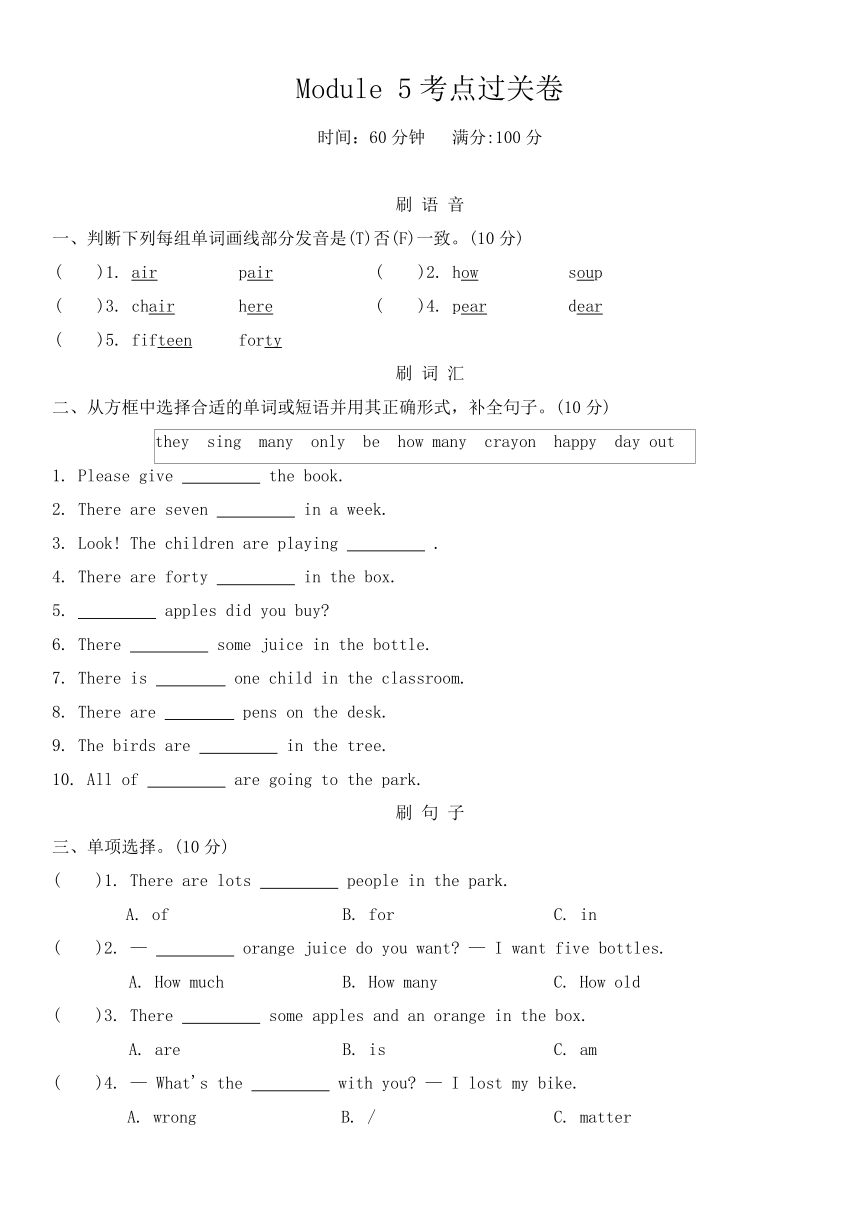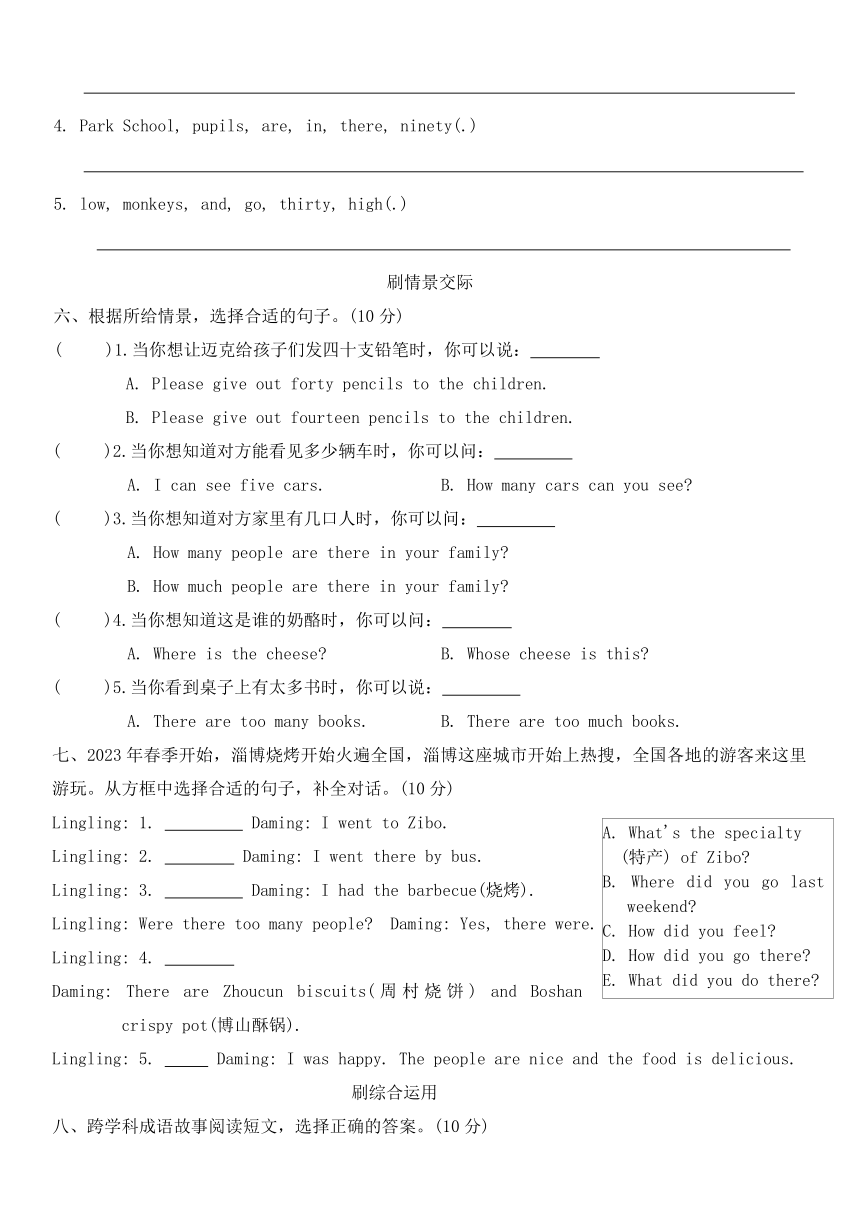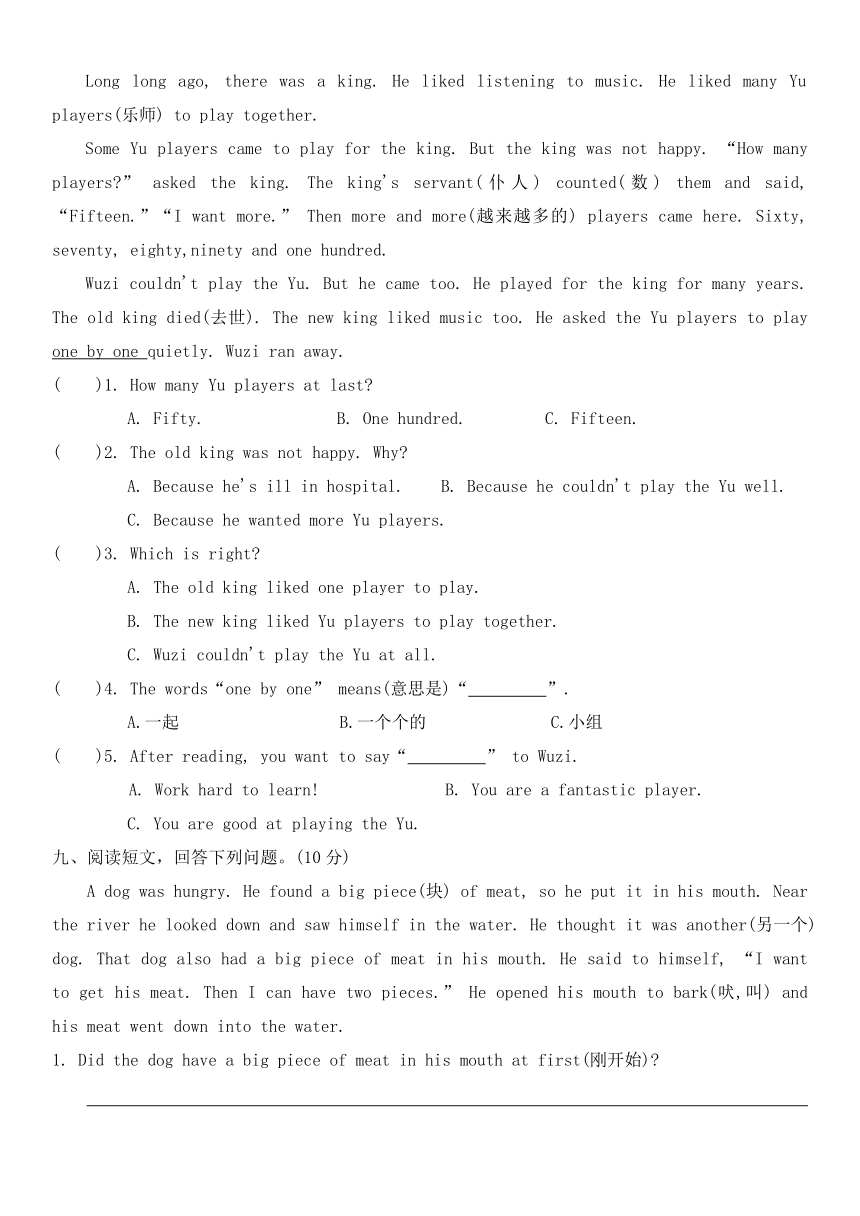Module 5 单元试卷(含解析)-2025-2026学年外研版(三起)英语五年级上册
文档属性
| 名称 | Module 5 单元试卷(含解析)-2025-2026学年外研版(三起)英语五年级上册 |  | |
| 格式 | docx | ||
| 文件大小 | 61.9KB | ||
| 资源类型 | 教案 | ||
| 版本资源 | 外研版(三年级起点) | ||
| 科目 | 英语 | ||
| 更新时间 | 2025-07-28 21:36:09 | ||
图片预览




文档简介
Module 5考点过关卷
时间:60分钟 满分:100分
刷 语 音
一、判断下列每组单词画线部分发音是(T)否(F)一致。(10分)
( )1. air pair ( )2. how soup
( )3. chair here ( )4. pear dear
( )5. fifteen forty
刷 词 汇
二、从方框中选择合适的单词或短语并用其正确形式,补全句子。(10分)
they sing many only be how many crayon happy day out
1. Please give the book.
2. There are seven in a week.
3. Look! The children are playing .
4. There are forty in the box.
5. apples did you buy
6. There some juice in the bottle.
7. There is one child in the classroom.
8. There are pens on the desk.
9. The birds are in the tree.
10. All of are going to the park.
刷 句 子
三、单项选择。(10分)
( )1. There are lots people in the park.
A. of B. for C. in
( )2. — orange juice do you want — I want five bottles.
A. How much B. How many C. How old
( )3. There some apples and an orange in the box.
A. are B. is C. am
( )4. — What's the with you — I lost my bike.
A. wrong B. / C. matter
( )5. There enough bags. Please give one to me.
A.is B. are C. isn't
( )6. I twenty crayons yesterday.
A. buy B. bought C. have
( )7. There's one book on the floor.
A. only B. too C. all
( )8. Please give the crayons.
A. up B. out C. /
( )9. Thirty elephants are a row.
A. on B. of C. in
( )10. The writer Wang Wei wrote the poem“红豆生南国,春来发几枝” for .
A.王维 B.李白 C.李龟年
四、按要求完成句子。(10分)
1. There are forty students in our class. (对画线部分提问)
2. I bought one kilo of rice. (对画线部分提问)
3. I went to the British Museum. (改为否定句)
4. There are some crayons in the pencil box. (改为一般疑问句)
5. I bought some bananas.(改为一般疑问句,并作肯定回答)
五、连词成句。(10分)
1. many, are, bears, there, so (.)
2. faces, you, how, can, many, see( )
3. two, I, legs, have(.)
4. Park School, pupils, are, in, there, ninety(.)
5. low, monkeys, and, go, thirty, high(.)
刷情景交际
六、根据所给情景,选择合适的句子。(10分)
( )1.当你想让迈克给孩子们发四十支铅笔时,你可以说:
A. Please give out forty pencils to the children.
B. Please give out fourteen pencils to the children.
( )2.当你想知道对方能看见多少辆车时,你可以问:
A. I can see five cars. B. How many cars can you see
( )3.当你想知道对方家里有几口人时,你可以问:
A. How many people are there in your family
B. How much people are there in your family
( )4.当你想知道这是谁的奶酪时,你可以问:
A. Where is the cheese B. Whose cheese is this
( )5.当你看到桌子上有太多书时,你可以说:
A. There are too many books. B. There are too much books.
七、2023年春季开始,淄博烧烤开始火遍全国,淄博这座城市开始上热搜,全国各地的游客来这里游玩。从方框中选择合适的句子,补全对话。(10分)
Lingling: 1. Daming: I went to Zibo.
Lingling: 2. Daming: I went there by bus.
Lingling: 3. Daming: I had the barbecue(烧烤).
Lingling: Were there too many people Daming: Yes, there were.
Lingling: 4.
Daming: There are Zhoucun biscuits(周村烧饼) and Boshan crispy pot(博山酥锅).
Lingling: 5. Daming: I was happy. The people are nice and the food is delicious.
刷综合运用
八、跨学科成语故事阅读短文,选择正确的答案。(10分)
Long long ago, there was a king. He liked listening to music. He liked many Yu players(乐师) to play together.
Some Yu players came to play for the king. But the king was not happy. “How many players ” asked the king. The king's servant(仆人) counted(数) them and said, “Fifteen.”“I want more.” Then more and more(越来越多的) players came here. Sixty, seventy, eighty,ninety and one hundred.
Wuzi couldn't play the Yu. But he came too. He played for the king for many years. The old king died(去世). The new king liked music too. He asked the Yu players to play one by one quietly. Wuzi ran away.
( )1. How many Yu players at last
A. Fifty. B. One hundred. C. Fifteen.
( )2. The old king was not happy. Why
A. Because he's ill in hospital. B. Because he couldn't play the Yu well.
C. Because he wanted more Yu players.
( )3. Which is right
A. The old king liked one player to play.
B. The new king liked Yu players to play together.
C. Wuzi couldn't play the Yu at all.
( )4. The words“one by one” means(意思是)“ ”.
A.一起 B.一个个的 C.小组
( )5. After reading, you want to say“ ” to Wuzi.
A. Work hard to learn! B. You are a fantastic player.
C. You are good at playing the Yu.
九、阅读短文,回答下列问题。(10分)
A dog was hungry. He found a big piece(块) of meat, so he put it in his mouth. Near the river he looked down and saw himself in the water. He thought it was another(另一个) dog. That dog also had a big piece of meat in his mouth. He said to himself, “I want to get his meat. Then I can have two pieces.” He opened his mouth to bark(吠,叫) and his meat went down into the water.
1. Did the dog have a big piece of meat in his mouth at first(刚开始)
2. Was there another dog in the water
3. Did the dog want to get two pieces of meat
4. Did the dog get two pieces of meat
5. What do you think of the dog
十、八仙过海,各显神通。Miss Wang 对班上同学们的才艺进行了调查,下面是调查的结果。根据图表填空,数字以英文单词呈现。(10分)
1. There are students in Miss Wang's class.
2. students can draw.
3. The number of is 3.
4. The number of is the mos
5. The number of dancing and playing the guitar is .
参考答案:
一、1~5 T F F F F
1.两个单词画线部分发音都为/e /,故填T。
2. how 画线部分发音为/a /, soup 画线部分发音为/u:/,故填F。
3. chair 画线部分发音为/e /, here画线部分发音为/ /,故填F。
4. pear画线部分发音为/e /, dear画线部分发音为/ /,故填F。
5. fifteen画线部分发音为/ti n/, fifty画线部分发音为/ ti/,故填F。
二、1. out 2. days 3. happily 4. crayons
5. How many 6. is 7. only 8. many
9. singing 10. them
1.由句意“请把书分发下去”可知,此处用固定搭配 give out,故填 out。
2.由常识可知,一周有七天,故填 days。
3.句子为现在进行时,且不缺少任何成分,因此用副词修饰动词, happy 的副词形式是 happily,故填 happily。
4.由句意“盒子里有四十只蜡笔”可知,此处用名词 crayon,且应用其复数形式,故填 crayons。
5.由句意“你买了多少苹果”可知,此处用 how many询问数量,故填 How many。
6. juice为不可数名词, be动词用 is,故填 is。
7.由句意“教室里只有一个孩子”可知,此处用副词 only,故填 only。
8.由句意“书桌上有很多钢笔”可知,此处用形容词 many,故填 many。
9.由句意“鸟儿正在树上唱歌”可知,此处用动词sing,且此句为现在进行时,故填 singing。
10.由句意“他们都将去公园”可知,此处用代词they,且介词 of后应跟代词的宾格形式,故填them。
三、1~5 AAACB 6~10 BABCC
1. lots of是固定搭配,意为“许多,大量”,故选 A。
2. orange juice意为“橙汁”,是不可数名词,对不可数名词的数量提问用 how much,故选 A。
3. there be句型中,be动词的形式遵循就近原则。some apples是复数, be动词要用 are,故选 A。
4. “What's the matter ”是固定句型,意为“怎么了;出什么事了”,故选 C。
5. 本题主语 bags是复数, be动词用 are,故选B。
6. 根据 yesterday(昨天)可知,时态为一般过去时,动词用过去式, bought 是 buy的过去式,故选B。
7. only意为“仅仅”, too意为“也”,放于肯定句句末, all意为“全部”。句意:在地板上只有一本书, only符合题意,故选 A。
8. give up 意为“放弃”, give out 意为“分发”,give意为“给”,后接双宾语。句意:请分发蜡笔, give out符合句意,故选 B。
9. “排成一队”用“in a row”表示,故选 C。
10.此句选自王维的《相思》,是王维写给好友李龟年的,故选C。
四、1. How many students are there in your class
2. How much rice did you buy
3. I didn't go to the British Museum.
4. Are there any crayons in the pencil box
5.— Did you buy any bananas
—— Yes, I did.
1.对可数名词的数量提问,应用 how many,且第一人称 our 改为 your, 故填“How many students are there in your class ”。
2.对不可数名词的数量提问,应用“how much,故填“How much rice did you buy ”。
3.一般过去时态的否定句为“主语+didn’t+动词原形+其他.”,故填“I didn’t go to the British Museum.”。
4. there be句型变一般疑问句,将 be动词提前,且疑问句中用 any 代替 some 表示“一些”,故填“Are there any crayons in the pencil box ”。
5.一般过去时态的一般疑问句的基本结构是“Did+主语+动词原形+其他 ”,故填“— Did you buy any bananas — Yes, I did.”。
五、1. There are so many bears.
2. How many faces can you see
3. I have two legs.
4. There are ninety pupils in Park School.
5. Thirty monkeys go high and low.
1.由所给标点可知,句子是陈述句。根据词义连成句子:有很多熊。故答案为“There are so many bears.”。
2.由所给标点可知,句子是疑问句。根据词义连成句子:你能看到多少张脸 故答案为“How many faces can you see ”。
3.由所给标点可知,句子是陈述句。根据词义连成句子:我有两条腿。故答案为“I have two legs.”。
4.由所给标点可知,句子是陈述句。根据词义连成句子:在公园学校有九十名小学生。故答案为“There are ninety pupils in Park School.”。
5.由所给标点可知,句子是陈述句。根据词义连成句子:三十只猴子上上下下。故答案为“Thirty monkeys go high and low.”。
六、1~5 A B A BA
1.选项 A意为“请给孩子们分发四十支铅笔”,选项B意为“请给孩子们分发十四支铅笔”,故选A。
2.选项 A意为“我可以看见五辆车”。选项B意为“你能看见多少辆车”,故选 B。
3.选项 A 和B意为“在你家里有几口人”,people是集合名词,对可数名词数量提问,用how many。故选 A。
4.选项A意为“奶酪在哪里”,选项B意为“这是谁的奶酪”。故选 B。
5.选项 A 和B都意为“有太多书了”;题干中的books是名词复数形式,用 too many修饰,故选A。
七、1~5 BDEAC
1.由下句句意“我去了淄博”可知,此处应询问对方去了哪里,故选B。
2.由下句句意“我坐公交车去了那里”可知,此处应询问对方如何去淄博,故选D。
3.由下句句意“我吃了烧烤”可知,此处应询问对方做了什么,故选 E。
4.由下句句意“那里有周村烧饼和博山酥锅”可知,此处应询问对方那儿有什么特产,故选A。
5.由下句句意“我很开心。人们很友好,食物很美味”可知,此处应询问对方的感受,故选C。
八、1~5 BCCBA
1.由短文第二段倒数第一、二句可知,越来越多的乐师来到这里,最后达到了一百人,故选B。
2.由短文第二段第二句和第四句、五句可知,老国王不开心,他和仆人说他想要更多的乐师,故选C。
3.根据第二段可知,老国王喜欢许多乐师一起演奏,故A 项错误。根据第三段倒数第二句可知,新国王喜欢乐师单独演奏,故B 项错误。根据第三段第一句话可知,Wuzi不会演奏竽,C项正确,故选C。
4. one是“一个”, one by one意为“一个个的”,故选B。
5.根据第三段第一句话和最后一句话可知,Wuzi不会演奏竽,你想对他说:“努力学吧”,故选 A。
九、1. Yes, he did.
2. No, there wasn't.
3. Yes, he did.
4. No, he didn't.
5. He is too greedy. (答案不唯一)
1.由短文第二句可知,狗嘴里有一大块肉,故填“Yes, he did.”。
2.通读短文可知,水里的狗是他的影子,故填“No, there wasn't.”。
3.由短文倒数第二句可知,狗想要两块肉,故填“Yes, he did.”。
4.由短文倒数第一句可知,狗没有得到两块肉,故填“No, he didn’t.”。
十、1. fifty 2. Twelve 3. playing the violin
4. singing 5. sixteen
1. 由条形统计图可知,12+19+10+6+3=50,故答案为 fifty。
2.由 draw这一栏可知,会画画的学生是12人,故答案为 Twelve。
3. 由 play the violin这一栏可知,拉小提琴的学生是3人,且 of 后跟动词-ing 形式,故答案为playing the violin。
4.由条形统计图可知,唱歌的人数最多,故答案为singing。
5. 由 dance和 play the guitar这两栏可知,会这两项的总共有10+6=16,故答案为 sixteen。
时间:60分钟 满分:100分
刷 语 音
一、判断下列每组单词画线部分发音是(T)否(F)一致。(10分)
( )1. air pair ( )2. how soup
( )3. chair here ( )4. pear dear
( )5. fifteen forty
刷 词 汇
二、从方框中选择合适的单词或短语并用其正确形式,补全句子。(10分)
they sing many only be how many crayon happy day out
1. Please give the book.
2. There are seven in a week.
3. Look! The children are playing .
4. There are forty in the box.
5. apples did you buy
6. There some juice in the bottle.
7. There is one child in the classroom.
8. There are pens on the desk.
9. The birds are in the tree.
10. All of are going to the park.
刷 句 子
三、单项选择。(10分)
( )1. There are lots people in the park.
A. of B. for C. in
( )2. — orange juice do you want — I want five bottles.
A. How much B. How many C. How old
( )3. There some apples and an orange in the box.
A. are B. is C. am
( )4. — What's the with you — I lost my bike.
A. wrong B. / C. matter
( )5. There enough bags. Please give one to me.
A.is B. are C. isn't
( )6. I twenty crayons yesterday.
A. buy B. bought C. have
( )7. There's one book on the floor.
A. only B. too C. all
( )8. Please give the crayons.
A. up B. out C. /
( )9. Thirty elephants are a row.
A. on B. of C. in
( )10. The writer Wang Wei wrote the poem“红豆生南国,春来发几枝” for .
A.王维 B.李白 C.李龟年
四、按要求完成句子。(10分)
1. There are forty students in our class. (对画线部分提问)
2. I bought one kilo of rice. (对画线部分提问)
3. I went to the British Museum. (改为否定句)
4. There are some crayons in the pencil box. (改为一般疑问句)
5. I bought some bananas.(改为一般疑问句,并作肯定回答)
五、连词成句。(10分)
1. many, are, bears, there, so (.)
2. faces, you, how, can, many, see( )
3. two, I, legs, have(.)
4. Park School, pupils, are, in, there, ninety(.)
5. low, monkeys, and, go, thirty, high(.)
刷情景交际
六、根据所给情景,选择合适的句子。(10分)
( )1.当你想让迈克给孩子们发四十支铅笔时,你可以说:
A. Please give out forty pencils to the children.
B. Please give out fourteen pencils to the children.
( )2.当你想知道对方能看见多少辆车时,你可以问:
A. I can see five cars. B. How many cars can you see
( )3.当你想知道对方家里有几口人时,你可以问:
A. How many people are there in your family
B. How much people are there in your family
( )4.当你想知道这是谁的奶酪时,你可以问:
A. Where is the cheese B. Whose cheese is this
( )5.当你看到桌子上有太多书时,你可以说:
A. There are too many books. B. There are too much books.
七、2023年春季开始,淄博烧烤开始火遍全国,淄博这座城市开始上热搜,全国各地的游客来这里游玩。从方框中选择合适的句子,补全对话。(10分)
Lingling: 1. Daming: I went to Zibo.
Lingling: 2. Daming: I went there by bus.
Lingling: 3. Daming: I had the barbecue(烧烤).
Lingling: Were there too many people Daming: Yes, there were.
Lingling: 4.
Daming: There are Zhoucun biscuits(周村烧饼) and Boshan crispy pot(博山酥锅).
Lingling: 5. Daming: I was happy. The people are nice and the food is delicious.
刷综合运用
八、跨学科成语故事阅读短文,选择正确的答案。(10分)
Long long ago, there was a king. He liked listening to music. He liked many Yu players(乐师) to play together.
Some Yu players came to play for the king. But the king was not happy. “How many players ” asked the king. The king's servant(仆人) counted(数) them and said, “Fifteen.”“I want more.” Then more and more(越来越多的) players came here. Sixty, seventy, eighty,ninety and one hundred.
Wuzi couldn't play the Yu. But he came too. He played for the king for many years. The old king died(去世). The new king liked music too. He asked the Yu players to play one by one quietly. Wuzi ran away.
( )1. How many Yu players at last
A. Fifty. B. One hundred. C. Fifteen.
( )2. The old king was not happy. Why
A. Because he's ill in hospital. B. Because he couldn't play the Yu well.
C. Because he wanted more Yu players.
( )3. Which is right
A. The old king liked one player to play.
B. The new king liked Yu players to play together.
C. Wuzi couldn't play the Yu at all.
( )4. The words“one by one” means(意思是)“ ”.
A.一起 B.一个个的 C.小组
( )5. After reading, you want to say“ ” to Wuzi.
A. Work hard to learn! B. You are a fantastic player.
C. You are good at playing the Yu.
九、阅读短文,回答下列问题。(10分)
A dog was hungry. He found a big piece(块) of meat, so he put it in his mouth. Near the river he looked down and saw himself in the water. He thought it was another(另一个) dog. That dog also had a big piece of meat in his mouth. He said to himself, “I want to get his meat. Then I can have two pieces.” He opened his mouth to bark(吠,叫) and his meat went down into the water.
1. Did the dog have a big piece of meat in his mouth at first(刚开始)
2. Was there another dog in the water
3. Did the dog want to get two pieces of meat
4. Did the dog get two pieces of meat
5. What do you think of the dog
十、八仙过海,各显神通。Miss Wang 对班上同学们的才艺进行了调查,下面是调查的结果。根据图表填空,数字以英文单词呈现。(10分)
1. There are students in Miss Wang's class.
2. students can draw.
3. The number of is 3.
4. The number of is the mos
5. The number of dancing and playing the guitar is .
参考答案:
一、1~5 T F F F F
1.两个单词画线部分发音都为/e /,故填T。
2. how 画线部分发音为/a /, soup 画线部分发音为/u:/,故填F。
3. chair 画线部分发音为/e /, here画线部分发音为/ /,故填F。
4. pear画线部分发音为/e /, dear画线部分发音为/ /,故填F。
5. fifteen画线部分发音为/ti n/, fifty画线部分发音为/ ti/,故填F。
二、1. out 2. days 3. happily 4. crayons
5. How many 6. is 7. only 8. many
9. singing 10. them
1.由句意“请把书分发下去”可知,此处用固定搭配 give out,故填 out。
2.由常识可知,一周有七天,故填 days。
3.句子为现在进行时,且不缺少任何成分,因此用副词修饰动词, happy 的副词形式是 happily,故填 happily。
4.由句意“盒子里有四十只蜡笔”可知,此处用名词 crayon,且应用其复数形式,故填 crayons。
5.由句意“你买了多少苹果”可知,此处用 how many询问数量,故填 How many。
6. juice为不可数名词, be动词用 is,故填 is。
7.由句意“教室里只有一个孩子”可知,此处用副词 only,故填 only。
8.由句意“书桌上有很多钢笔”可知,此处用形容词 many,故填 many。
9.由句意“鸟儿正在树上唱歌”可知,此处用动词sing,且此句为现在进行时,故填 singing。
10.由句意“他们都将去公园”可知,此处用代词they,且介词 of后应跟代词的宾格形式,故填them。
三、1~5 AAACB 6~10 BABCC
1. lots of是固定搭配,意为“许多,大量”,故选 A。
2. orange juice意为“橙汁”,是不可数名词,对不可数名词的数量提问用 how much,故选 A。
3. there be句型中,be动词的形式遵循就近原则。some apples是复数, be动词要用 are,故选 A。
4. “What's the matter ”是固定句型,意为“怎么了;出什么事了”,故选 C。
5. 本题主语 bags是复数, be动词用 are,故选B。
6. 根据 yesterday(昨天)可知,时态为一般过去时,动词用过去式, bought 是 buy的过去式,故选B。
7. only意为“仅仅”, too意为“也”,放于肯定句句末, all意为“全部”。句意:在地板上只有一本书, only符合题意,故选 A。
8. give up 意为“放弃”, give out 意为“分发”,give意为“给”,后接双宾语。句意:请分发蜡笔, give out符合句意,故选 B。
9. “排成一队”用“in a row”表示,故选 C。
10.此句选自王维的《相思》,是王维写给好友李龟年的,故选C。
四、1. How many students are there in your class
2. How much rice did you buy
3. I didn't go to the British Museum.
4. Are there any crayons in the pencil box
5.— Did you buy any bananas
—— Yes, I did.
1.对可数名词的数量提问,应用 how many,且第一人称 our 改为 your, 故填“How many students are there in your class ”。
2.对不可数名词的数量提问,应用“how much,故填“How much rice did you buy ”。
3.一般过去时态的否定句为“主语+didn’t+动词原形+其他.”,故填“I didn’t go to the British Museum.”。
4. there be句型变一般疑问句,将 be动词提前,且疑问句中用 any 代替 some 表示“一些”,故填“Are there any crayons in the pencil box ”。
5.一般过去时态的一般疑问句的基本结构是“Did+主语+动词原形+其他 ”,故填“— Did you buy any bananas — Yes, I did.”。
五、1. There are so many bears.
2. How many faces can you see
3. I have two legs.
4. There are ninety pupils in Park School.
5. Thirty monkeys go high and low.
1.由所给标点可知,句子是陈述句。根据词义连成句子:有很多熊。故答案为“There are so many bears.”。
2.由所给标点可知,句子是疑问句。根据词义连成句子:你能看到多少张脸 故答案为“How many faces can you see ”。
3.由所给标点可知,句子是陈述句。根据词义连成句子:我有两条腿。故答案为“I have two legs.”。
4.由所给标点可知,句子是陈述句。根据词义连成句子:在公园学校有九十名小学生。故答案为“There are ninety pupils in Park School.”。
5.由所给标点可知,句子是陈述句。根据词义连成句子:三十只猴子上上下下。故答案为“Thirty monkeys go high and low.”。
六、1~5 A B A BA
1.选项 A意为“请给孩子们分发四十支铅笔”,选项B意为“请给孩子们分发十四支铅笔”,故选A。
2.选项 A意为“我可以看见五辆车”。选项B意为“你能看见多少辆车”,故选 B。
3.选项 A 和B意为“在你家里有几口人”,people是集合名词,对可数名词数量提问,用how many。故选 A。
4.选项A意为“奶酪在哪里”,选项B意为“这是谁的奶酪”。故选 B。
5.选项 A 和B都意为“有太多书了”;题干中的books是名词复数形式,用 too many修饰,故选A。
七、1~5 BDEAC
1.由下句句意“我去了淄博”可知,此处应询问对方去了哪里,故选B。
2.由下句句意“我坐公交车去了那里”可知,此处应询问对方如何去淄博,故选D。
3.由下句句意“我吃了烧烤”可知,此处应询问对方做了什么,故选 E。
4.由下句句意“那里有周村烧饼和博山酥锅”可知,此处应询问对方那儿有什么特产,故选A。
5.由下句句意“我很开心。人们很友好,食物很美味”可知,此处应询问对方的感受,故选C。
八、1~5 BCCBA
1.由短文第二段倒数第一、二句可知,越来越多的乐师来到这里,最后达到了一百人,故选B。
2.由短文第二段第二句和第四句、五句可知,老国王不开心,他和仆人说他想要更多的乐师,故选C。
3.根据第二段可知,老国王喜欢许多乐师一起演奏,故A 项错误。根据第三段倒数第二句可知,新国王喜欢乐师单独演奏,故B 项错误。根据第三段第一句话可知,Wuzi不会演奏竽,C项正确,故选C。
4. one是“一个”, one by one意为“一个个的”,故选B。
5.根据第三段第一句话和最后一句话可知,Wuzi不会演奏竽,你想对他说:“努力学吧”,故选 A。
九、1. Yes, he did.
2. No, there wasn't.
3. Yes, he did.
4. No, he didn't.
5. He is too greedy. (答案不唯一)
1.由短文第二句可知,狗嘴里有一大块肉,故填“Yes, he did.”。
2.通读短文可知,水里的狗是他的影子,故填“No, there wasn't.”。
3.由短文倒数第二句可知,狗想要两块肉,故填“Yes, he did.”。
4.由短文倒数第一句可知,狗没有得到两块肉,故填“No, he didn’t.”。
十、1. fifty 2. Twelve 3. playing the violin
4. singing 5. sixteen
1. 由条形统计图可知,12+19+10+6+3=50,故答案为 fifty。
2.由 draw这一栏可知,会画画的学生是12人,故答案为 Twelve。
3. 由 play the violin这一栏可知,拉小提琴的学生是3人,且 of 后跟动词-ing 形式,故答案为playing the violin。
4.由条形统计图可知,唱歌的人数最多,故答案为singing。
5. 由 dance和 play the guitar这两栏可知,会这两项的总共有10+6=16,故答案为 sixteen。
同课章节目录
- Module 1
- Unit 1 Did you come back yesterday?
- Unit 2 We bought ice creams.
- Module 2
- Unit 1 What did you buy?
- Unit 2 How much cheese did you buy?
- Module 3
- Unit 1 Where did you go?
- Unit 2 Daming took a photo of his father.
- Module 4
- Unit 1 Mum bought a new T-shirt for me.
- Unit 2 What's the matter with Daming?
- Module 5
- Unit 1 There are only nineteen crayons
- Unit 2 There are forty.
- Module 6
- Unit 1 You can play football well.
- Unit 2 He ran very fast.
- Module 7
- Unit 1 He can't see.
- Unit 2 This little girl can't walk.
- Module 8
- Unit 1 What time does your school start?
- Unit 2 Yesterday I went to Sam and Amy's school.
- Module 9
- Unit 1 Are you feeling bored?
- Unit 2 I feel happy.
- Review Module
- Unit 1
- Unit 2
- Module 10
- Unit 1 He was in the kitchen.
- Unit 2 Don't shout, please!
- 旧版资料
- Module 1 London
- Module 2 Shopping
- Module 3 At the Weekend
- Module 4 Possession
- Module 5 In Class
- Module 6 Self-assessment
- Module 7 Community
- Module 8 School
- Module 9 Feelings
- Module 10 Manners
- Review Module
